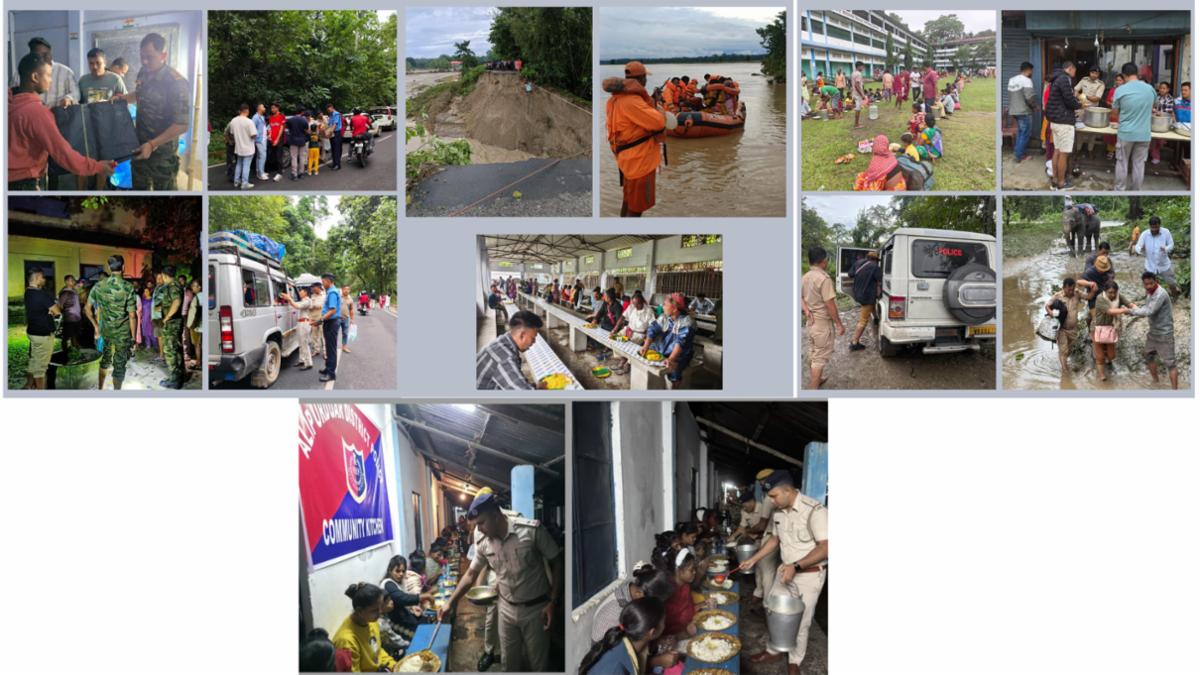Article Body
North Bengal Floods 2025: Police Race Against Time to Rescue Stranded Residents and Tourists

North Bengal, October 6, 2025: A sudden surge in rainfall across North Bengal has triggered catastrophic flooding, submerging entire villages and leaving thousands stranded. Rivers like Teesta, Jaldhaka, and Mahananda have breached their banks, inundating towns and hampering transportation networks. Authorities have described the situation as “critical,” with immediate relief operations underway.
The disaster struck late last week, with meteorological departments issuing high-alert warnings. By Sunday morning, floodwaters had engulfed multiple districts including Darjeeling, Jalpaiguri, Cooch Behar, and Alipurduar. Eyewitnesses reported streets turning into rivers, homes partially submerged, and families seeking higher ground for safety.
Police and Administration: A War-Time Response
In response to the crisis, North Bengal’s police forces have adopted a “war-time operational stance.” Officers, local volunteers, and disaster management teams are coordinating to evacuate stranded tourists, local residents, and vulnerable populations. Special rescue units equipped with inflatable boats and emergency supplies are deployed across affected zones.
A senior police officer stated, “We are working round the clock to ensure every stranded individual is rescued and brought to safety. Our primary objective is to prevent casualties while providing immediate aid to those in need.”
The police have also set up temporary command centers in strategic locations to monitor water levels, track vulnerable areas, and streamline relief distribution. Helicopter sorties are reportedly being considered for the most inaccessible villages, where road connectivity has been completely severed.
Community Kitchens and Relief Measures
In addition to rescue operations, police and local authorities have established multiple community kitchens to provide hot meals, clean drinking water, and essential medical supplies. These facilities are functioning in collaboration with NGOs, volunteers, and local municipal bodies.
The initiative ensures that flood-affected families have access to basic sustenance even as relief teams work tirelessly to reach remote areas. Residents in shelters have expressed gratitude for the prompt response, noting that the police-led community kitchens have become a lifeline during the crisis.
Stranded Tourists and Roadblocks
North Bengal, a hub of tourism, has seen several hotels and lodges partially submerged. Hundreds of tourists from within India and abroad were caught off guard by the rapidly rising waters. Police and local guides are coordinating evacuation efforts, prioritizing children, elderly travelers, and foreign tourists.
Several key highways and railway links have been rendered unusable, with landslides reported in hilly areas such as Kalimpong and Darjeeling. Authorities are advising people to avoid non-essential travel and to remain vigilant about official flood updates.
The Human Impact
Though official casualty figures have yet to be fully verified, preliminary reports indicate widespread property damage and temporary displacement of thousands of families. Hospitals and health centers are working to address waterborne illnesses, injuries, and emergencies caused by the flooding.
Residents recount harrowing experiences of being trapped on rooftops or in vehicles, relying on rescue teams for survival. Many communities have activated informal support networks, helping vulnerable neighbors reach higher ground until formal assistance arrives.
Historical Context and Preparedness
North Bengal has faced periodic flooding in the past, notably in 2017 and 2020, when heavy monsoon rains caused extensive damage to agriculture, infrastructure, and livelihoods. However, local authorities claim that this year’s floods have exceeded previous records in terms of intensity and spread.
Police and disaster management teams have reportedly integrated lessons from past emergencies, improving coordination, real-time monitoring of water levels, and rapid mobilization of resources. This proactive approach appears to be mitigating potential casualties despite the scale of the disaster.
Looking Ahead: Recovery and Resilience
As floodwaters gradually recede in some areas, attention is shifting toward long-term recovery. Authorities are prioritizing the restoration of roads, bridges, and communication lines. Relief materials, including tents, medicines, and hygiene kits, continue to reach affected zones.
Officials emphasize community participation in recovery efforts, urging local residents to assist in clean-up drives and support displaced neighbors. Environmental experts are also calling for a review of flood-control measures, river embankments, and early-warning systems to prevent similar disasters in the future.
Conclusion
The ongoing North Bengal flood crisis is a stark reminder of the vulnerability of flood-prone regions and the importance of swift, coordinated disaster management. The police and local authorities have demonstrated resilience and efficiency in their emergency response, providing a critical lifeline to thousands of stranded residents and tourists.
While the floods have caused substantial disruption, the combined efforts of law enforcement, volunteers, and community support are helping North Bengal navigate this unprecedented natural calamity. For residents, the hope remains that prompt rescue and relief will pave the way for a faster recovery and stronger preparedness for the future.

Comments